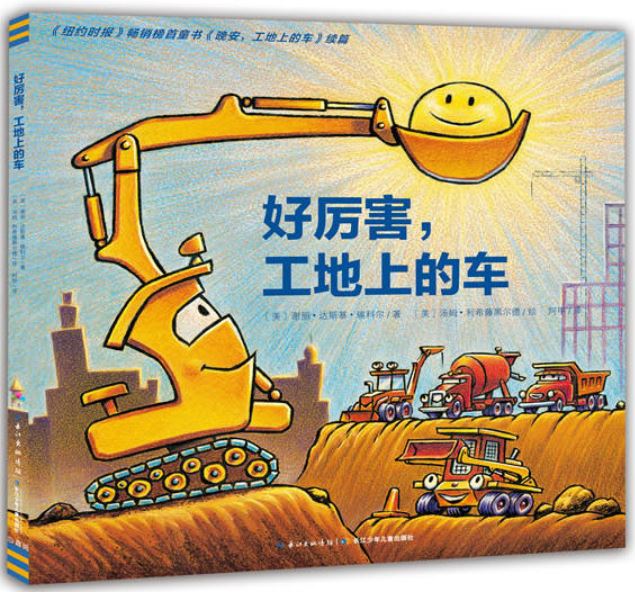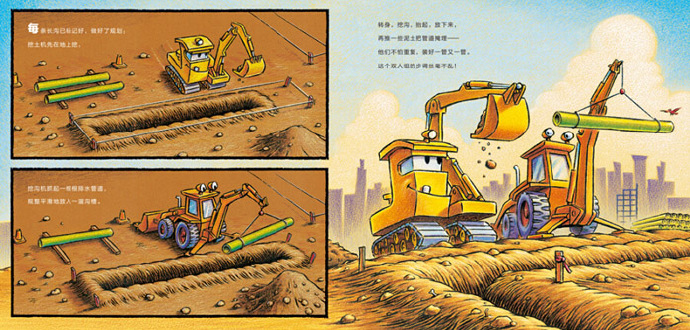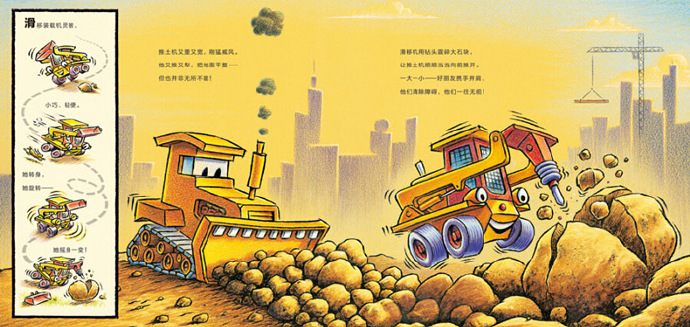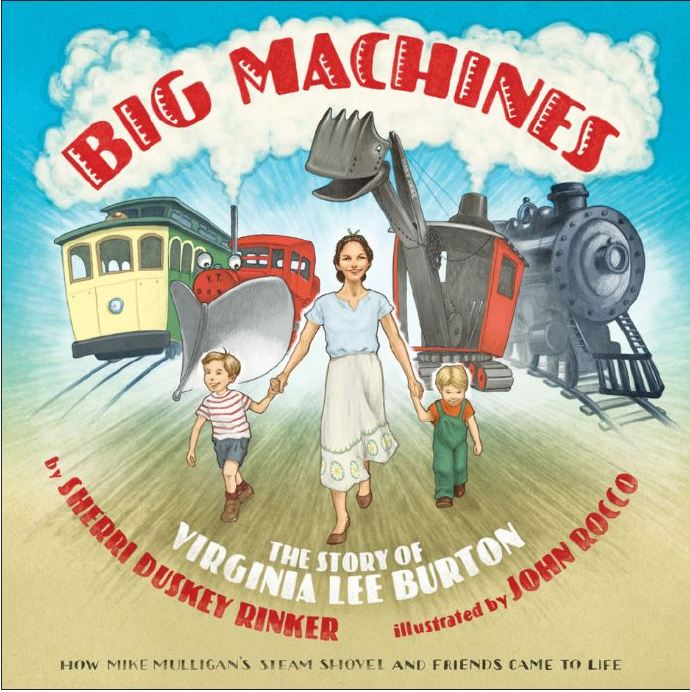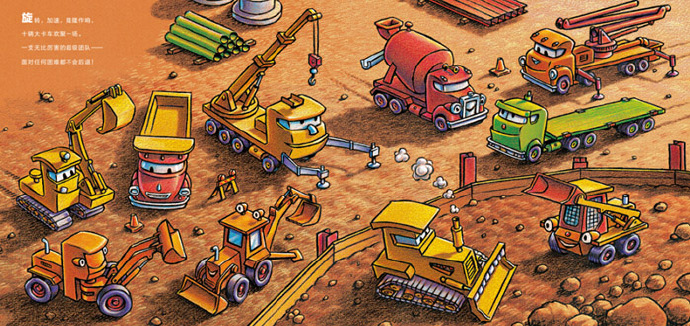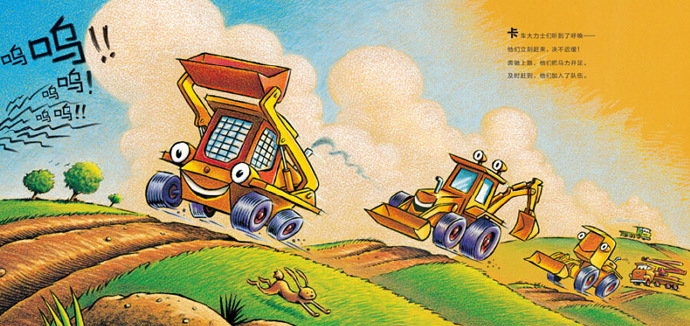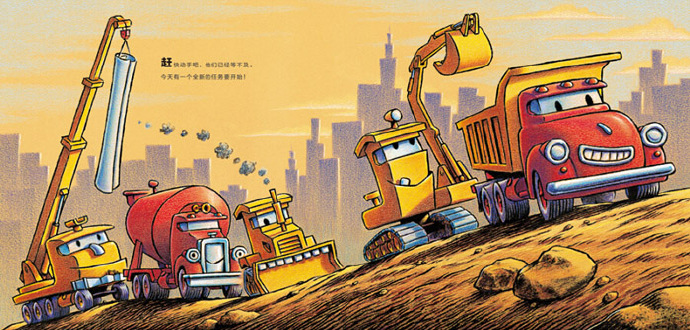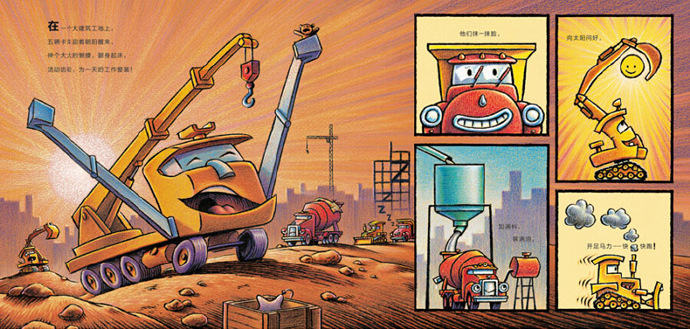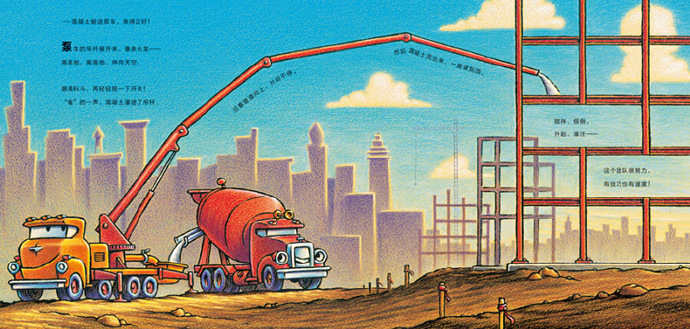On Valentine’s Day 2017, a picture book titled “Amazing Construction Trucks” launched in the US, drawing enthusiastic cheers from young fans. You might be a little surprised—why a book about construction sites and construction vehicles was released on Valentine’s Day? But if you’ve ever had a child or two fascinated by cars, machinery, or construction sites, you’ll understand the obsession that rivals the love between lovers. Furthermore, this new book is a sequel to the incredibly popular “Goodnight, Construction Trucks,” published in 2012. It reached number one on the New York Times bestseller list and has countless young fans. They’ve been eagerly awaiting more exciting stories about the capable and fun-loving construction vehicles on construction sites for five years. How could they not be impatient?
Looking back, the five-year wait was worth it. This sequel not only builds on the success of the original, but also adds even more excitement and variety. In the first installment, the protagonists were five powerful construction vehicles: a crane, a cement mixer, a dump truck (a dump truck), a bulldozer, and a large excavator (an excavator). In the sequel, they’re still the protagonists, but faced with a project of unprecedented scale, these five vehicles alone are simply not enough. So, the cement mixer blares its horn, and five other powerful trucks step up to the plate: a skid steer loader, a trencher, a flatbed trailer, a front-end loader, and a concrete pump truck! What a professional team, isn’t it? On Amazon, some readers complained that several of the construction vehicles seemed unfamiliar to adults, not just children. But surprisingly, the children loved them just as much. The book clearly demonstrates the uses of these vehicles, and to children, their amazing abilities border on magic.
In the previous episode, five construction vehicles debuted one by one, showcasing their individual capabilities before entering a nighttime ritual on the construction site. It was a picture book with a harmonious balance of movement and stillness, seamlessly blending the frenzy of construction vehicles on the construction site with the bedtime ritual. No wonder it’s so popular with children and adults alike. The sequel, “Amazing Construction Vehicles,” maintains this seamless fusion while also taking on a new chapter. The new story begins with a new day, as the five protagonists awaken to the rising sun, seamlessly connecting with the previous book. However, a massive new project soon emerges, injecting an element of excitement into the work. Instead of simply parading around one by one as in the previous installment, the five protagonists call upon five new partners to join them, and through teamwork, they work together to complete the task. Throughout the book, we encounter several perfect teamwork: a skid steer loader and a bulldozer clear obstacles; an excavator and a trencher work together to lay a pipeline; a flatbed trailer helps a crane deliver materials; a front-end loader and a dump truck clear dirt and gravel; and a concrete pump truck helps a cement mixer transport concrete to high ground. As the book puts it, “This incredible team is truly unbeatable!” The secret to their invincibility lies in the team’s camaraderie and cooperative spirit. Going a step further than the first book, the author emphasizes that even the most powerful construction vehicles are not omnipotent. More importantly, each vehicle has its own role within the team, and every member must work together wholeheartedly.
Careful readers will also notice a subtle but significant change in the sequel. In the first book, all the construction vehicles were male! Yes, the first five protagonists were all referred to as “he.” In the sequel, however, at least two of the new companions are referred to as “she”: the skid steer loader and the flatbed trailer. Besides the front-end loader, the other two could also be female. This is a very welcome change. After all, many young car enthusiasts are girls, and even more parents read with their children than mothers. Why should the heroes of construction sites only be male?
In fact, author Sherri Dusky Ricoeur is a woman. How did she come up with the idea of writing a book about construction vehicles on construction sites? It all came down to her young son. A mother of two boys, Sherri was already in her early forties when she wrote her debut children’s book, “Goodnight, Construction Vehicles.” At the time, she was still a professional designer. Her busy daytime schedule made her cherish her evenings with her two children. She always read stories to them, read with them, or just playfully played with them. Her youngest son was incredibly energetic, and every night before bed, he would toss and turn. He was also a huge car enthusiast, especially construction vehicles. So, the bedtime ritual depicted in “Goodnight, Moon” became a ritual of saying goodbye to various construction driveways. One night, as a weary Sherri left her son’s room, she saw the toy construction vehicles strewn across the floor. An idea struck her: Why not document this “eccentric” ritual of her son’s and turn it into a story? And why not consider publishing it as a book? After all, there are so many young car enthusiasts and their parents out there.
It turns out that since childhood, Sheri had dreamed of becoming a writer, and it was none other than Virginia Lee Burton, the creator of the picture book “Little House.” When Sheri was four, her grandmother read “Little House” to her, and she fell head over heels for it. The beautiful images and poetic language left a lasting impression on her. I also happened to be the one who translated the Chinese version of “Little House.” While the text isn’t written in verse, it possesses the rhythm of poetry. From that moment on, Sheri aspired to be a writer and poet, with Lee Burton as her role model. Sheri also loved drawing from a young age. Her schooling sometimes focused on art and sometimes literature, but after starting work, she initially pursued a design career that required the integration of text and illustration. This wasn’t her childhood dream, but somewhere along the way, she became the mother of two boys. And by some strange coincidence, Lee Burton is also a mother of two boys. “Little House” was originally written to teach her sons about the concept of time!
This is probably not entirely a coincidence. I prefer to believe that this is the magical power of role models, because Shelly is very obsessed with Lee Burton and his works. She knows that the mother is best at creating based on the interests of her two sons. Because of their fascination with various cars, Lee Burton also created “The Runaway Engine”, “McMulligan and His Steam Shovel”, “Caddy and a Big Snow”, “Cable Car Maple” and other must-have books for little car fans. I think Shelly’s successive creations such as “Goodnight, Cars on the Construction Site”, “Train Carnival Dreams” and “Amazing, Cars on the Construction Site” are obviously following and paying tribute to that predecessor. Shelly’s most recent book is “Big Machines: The Story of Virginia Lee Burton” (Big Machines: The Story of Virginia Lee Burton).
Machines: The Story of Virginia Lee
Burton, the book was published in September 2017. To create it, Sheri also visited Lee Burton’s eldest son, the renowned sculptor Aris Burton Demetrius, to collaborate with him on telling his mother’s story. Isn’t that a perfect dream come true?
However, Shelly’s success is also due to her collaboration with an illustrator like Tom Lichtenhold. The three books mentioned above are all Tom’s masterpieces of illustration. He almost perfectly blends the real world and the imaginary world, the lively and bustling scenes with the lazy and peaceful sleeping rituals. In “Amazing Trucks on the Construction Site”, he also accurately depicts the schematic diagrams of the use of various construction vehicles to a certain extent. Like his other book “Sharks Fighting Trains”, they are all masterpieces that seamlessly blend knowledge and entertainment. People can’t help but admire and say, “Amazing, Tom Lichtenhold!”
Written in Beijing on May 9, 2017
